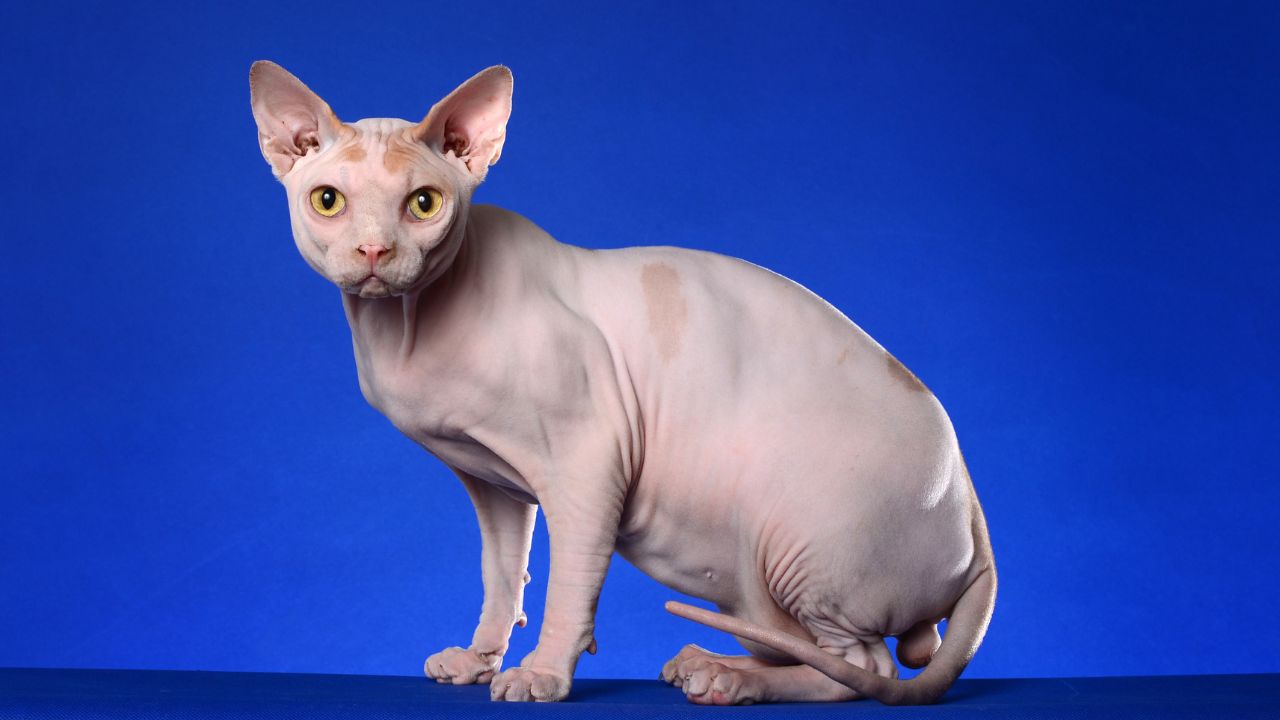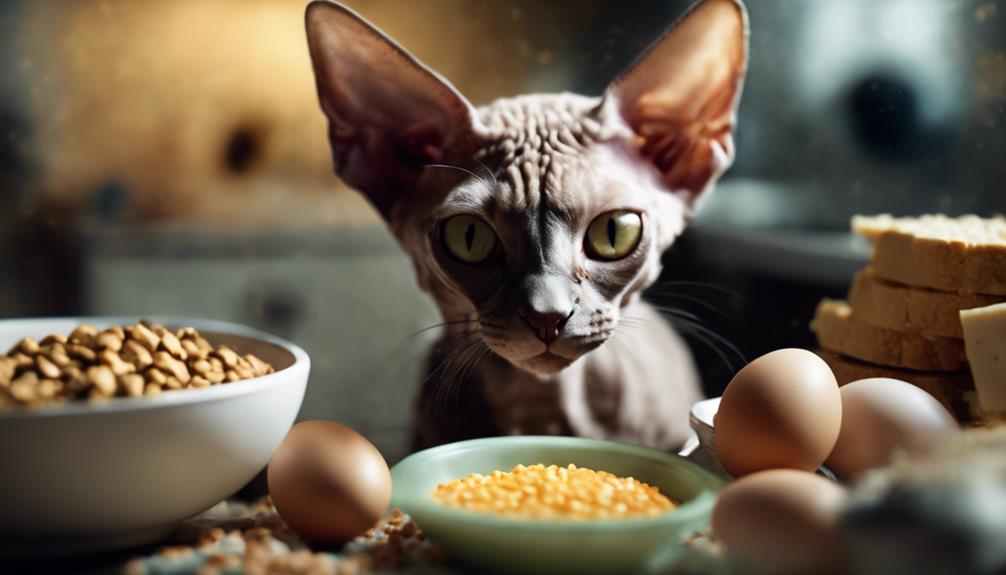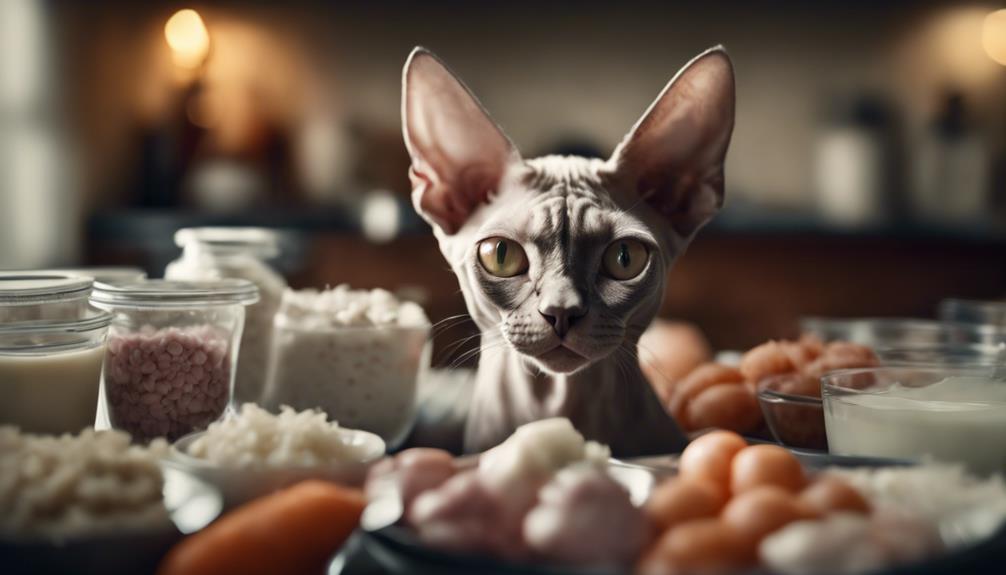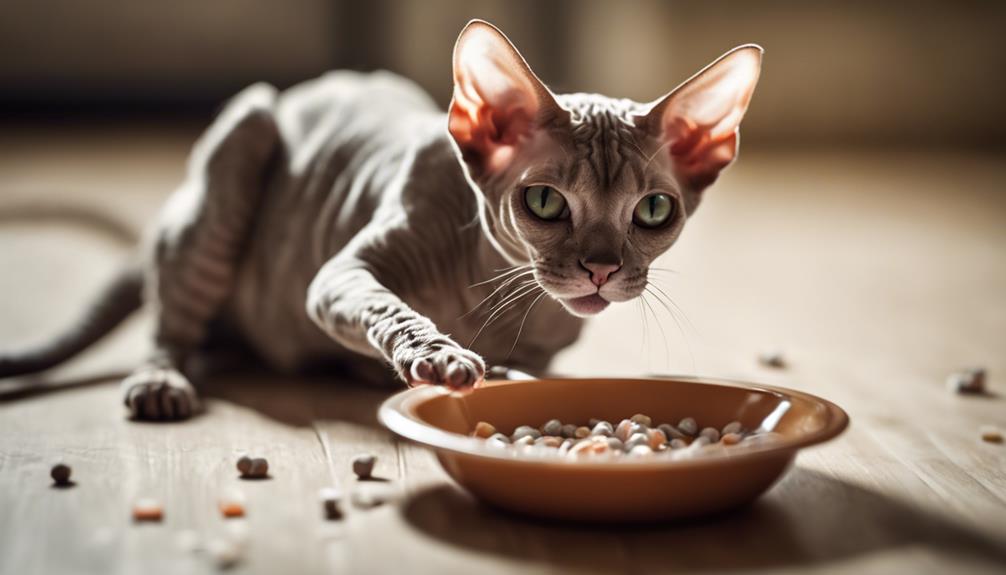Sphynx cats are a unique breed of felines that have captured the hearts of many pet owners. Known for their hairless appearance, many people wonder if Sphynx cats are natural or if their lack of fur is a result of human intervention. The answer is that hairlessness in cats is a naturally occurring genetic mutation, and the Sphynx was developed through selective breeding of these animals, starting in the 1960s.
The Sphynx cat, also known as the Canadian Sphynx, is a relatively new breed that originated in Toronto, Canada. The first hairless kitten was born in 1966 to a domestic shorthair cat. This kitten, named Prune, was bred with other cats to create the Sphynx breed we know today. The breed was officially recognized by the Cat Fanciers’ Association in 1985 and has since become a popular pet choice for those looking for a unique and friendly companion.
While Sphynx cats are a natural breed, they do require special care due to their lack of fur. Without fur to protect their skin, they are more susceptible to sunburn, dryness, and temperature changes. Sphynx cats also require regular bathing to remove excess oils from their skin. Despite these unique care requirements, Sphynx cats are known for their friendly and playful personalities, making them a beloved pet choice for many.
What Makes Sphynx Cats Hairless?
Sphynx cats are known for their unique hairlessness, which sets them apart from other cat breeds. But what makes them hairless? In this section, we will explore the factors that contribute to the Sphynx cat’s hairlessness.
Genetic Mutation
Hairlessness in cats is a naturally occurring genetic mutation. In the case of Sphynx cats, this mutation affects the gene that is responsible for providing hairs with their keratin protein as they emerge from the follicle. As a result, the hair is formed but has a weaker structure, making it easily damaged and dislodged. This mutation is recessive, meaning that both parents must carry the gene for hairlessness to produce a hairless kitten.
Selective Breeding
While the genetic mutation is responsible for the hairlessness of Sphynx cats, selective breeding played a significant role in developing the breed. The first hairless cat was born in Toronto, Canada, in 1966. Breeders then selectively bred hairless cats with other breeds, such as Devon Rex and American Shorthair, to create the Sphynx cat we know today.
Breed Standards
According to breed standards, the skin of the Sphynx cat should have the texture of chamois leather, with fine hairs or be completely hairless. The lack of hair makes Sphynx cats sensitive to sun exposure as they have no fur to protect their skin from harmful UV rays. Direct sun exposure should be limited, as these cats can get sunburned if exposed to sunlight for too long.
In conclusion, the hairlessness of Sphynx cats is due to a genetic mutation that affects the keratin protein in hair. Selective breeding played a role in developing the breed, and breed standards dictate that the skin should have the texture of chamois leather or be completely hairless.
Physical Characteristics of Sphynx Cats
Sphynx cats are a unique breed of felines that are known for their hairless bodies. While they may not have fur, they have a number of physical characteristics that make them stand out from other cats.
Skin and Coat
Sphynx cats have a unique skin type that is different from other breeds of cats. Their skin is often described as feeling like warm suede or a peach. It is soft, supple, and very sensitive. Because they do not have fur, their skin is exposed to the elements and can become easily irritated. Sphynx cats also have oily skin, which can lead to acne and other skin issues if not properly cared for.
Ears and Whiskers
Sphynx cats have large, wide-set ears that are often described as looking like bat ears. They are very expressive and can swivel and move in different directions. Sphynx cats also have whiskers, which are shorter and finer than those of other cats. Their whiskers are very sensitive and are used to help them navigate their environment.
Paw Pads
Sphynx cats have unique paw pads that are thick and wrinkled. This helps them grip surfaces and climb with ease. Their paw pads are also very sensitive and can be easily irritated if they come into contact with harsh chemicals or rough surfaces.
In conclusion, Sphynx cats have a number of physical characteristics that make them stand out from other cats. Their skin, ears, whiskers, and paw pads are all unique and require special care to keep them healthy and happy. If you’re considering bringing a Sphynx cat into your home, it’s important to do your research and make sure you’re prepared to provide them with the care they need.
Sphynx Cat Colors and Patterns
Sphynx cats may be hairless, but they still come in a wide variety of colors and patterns. Here are some of the most common:
Solid Colors
Solid-colored Sphynx cats have one color all over their body. They may be white, black, blue, red, cream, silver, golden, cameo, or any other solid color.
Tabby Patterns
Tabby Sphynx cats have distinctive markings on their body that resemble the letter “M” on their forehead. They may have stripes, spots, or swirls on their body. Tabby Sphynx cats come in a variety of colors, including brown, blue, silver, and red.
Tortoiseshell Patterns
Tortoiseshell Sphynx cats have a mix of two or more colors on their body. They may have patches of black, red, cream, and other colors on their body. Tortoiseshell Sphynx cats come in a variety of shades, including blue-cream, chestnut, cinnamon, lavender-cream, and fawn-cream.
Bicolor and Tricolor/Calico Patterns
Bicolor Sphynx cats have two colors on their body, while tricolor/calico Sphynx cats have three colors. These cats may have a white base color with patches of black, red, cream, or other colors on their body.
Ticking and Smoke Patterns
Ticking Sphynx cats have small spots of color on their body, while smoke Sphynx cats have a darker color at the roots of their hair that fades into a lighter color towards the tips.
In general, Sphynx cats can come in any color or pattern found in felines, and any combination of colors and patterns is acceptable. It is important to note that exposure to sunlight can intensify the color of a Sphynx cat’s skin.
Personality and Temperament of Sphynx Cats
Sphynx cats are known for their unique and striking appearance, but they are also beloved for their friendly and affectionate personalities. These cats are social creatures that love to be around people and other pets. They are often described as outgoing and inquisitive, and they enjoy exploring their surroundings.
One of the most notable traits of Sphynx cats is their intelligence. These cats are quick learners and are known for being able to understand and follow commands. They are also very curious and love to investigate new things, which can make them a lot of fun to be around.
Another aspect of the Sphynx cat’s personality is their affectionate nature. These cats love to be held and cuddled, and they are often referred to as “velcro cats” because of their tendency to stick close to their owners. They are also very vocal and will often meow to get attention or express their feelings.
Despite their hairless appearance, Sphynx cats are natural athletes and enjoy playing and exploring their environment. They are also good with children and other pets, making them a great choice for families.
In summary, Sphynx cats have outgoing personalities, are intelligent, affectionate, and playful. They are social creatures that love to be around people and other pets and are known for their inquisitive and vocal nature.
Health Issues in Sphynx Cats
Sphynx cats are known for their unique hairless appearance, but they are also prone to certain health issues. In this section, we will discuss some of the common health problems that affect Sphynx cats.
Hypertrophic Cardiomyopathy
One of the most common health issues in Sphynx cats is hypertrophic cardiomyopathy (HCM). This is a hereditary heart disease that affects the muscles of the heart, causing them to thicken. HCM can lead to heart failure and sudden death, so it is important to have your Sphynx cat screened for this condition. An echocardiogram is the best way to diagnose HCM.
Skin Problems
Sphynx cats lack the protection that fur provides, which makes them more susceptible to skin problems. They need frequent baths to keep their skin free from excess oils and dirt which can lead to skin problems. Urticaria pigmentosa is another Sphynx skin problem, it results in red pigmented spots on the skin.
Allergies
Sphynx cats are prone to allergies. They can be allergic to food, environmental allergens, or even the litter they use. Allergies can cause itching, scratching, and skin infections. If you notice your Sphynx cat scratching excessively or developing skin problems, it is important to have them evaluated by a veterinarian.
Dental Disease
Sphynx cats are also prone to dental disease, just like any other breed of cat. They can develop plaque, tartar, and gum disease if their teeth are not properly cared for. Regular dental cleanings and at-home dental care can help prevent dental disease in Sphynx cats.
In conclusion, Sphynx cats are prone to certain health issues, including hypertrophic cardiomyopathy, skin problems, allergies, and dental disease. It is important to have your Sphynx cat screened for these conditions and to provide them with proper care to prevent these health problems from developing.
Caring for Your Sphynx Cat
Sphynx cats are unique creatures that require special care. They are hairless, which means they have different grooming needs than other cats. In this section, we will discuss how to care for your Sphynx cat, including grooming, bathing, diet, and special care.
Grooming
Sphynx cats do not have hair, but they still need to be groomed regularly. They have a thin layer of fuzz on their skin, which can trap dirt and oil. To keep your Sphynx cat clean, you should brush them at least once a week. Use a soft bristle brush or a damp cloth to remove any dirt or oil from their skin.
Sphynx cats also have large ears, which can accumulate dirt and wax. To prevent ear infections, you should clean your cat’s ears once a week with a good ear cleaner. Use a cotton ball or a soft cloth to gently wipe the inside of their ears.

Bathing
Sphynx cats do not have hair to absorb oils from their skin, which means they can become greasy and dirty quickly. To keep your Sphynx cat clean, you should bathe them at least once a month. Use a gentle cat shampoo that is soap-free and made with natural ingredients like coconut oil.
When bathing your Sphynx cat, be sure to use warm water and avoid getting water in their ears. Dry your cat thoroughly with a towel or a hair dryer on a low setting.
Diet
Diet plays an important role in the health of your Sphynx cat. They are prone to obesity, so it’s important to feed them a balanced diet that is high in protein and low in carbohydrates. Choose a high-quality cat food that is specifically formulated for hairless cats.
You should also provide your Sphynx cat with fresh water at all times. They may prefer to drink from a water fountain or a running tap.
Special Care
Sphynx cats require special care to keep them healthy and happy. They are sensitive to temperature changes, so it’s important to keep them warm in colder weather. Provide them with a warm bed and keep their living space at a comfortable temperature.
Sphynx cats are also prone to sunburn and skin damage. Keep them indoors during the hottest parts of the day and provide them with a sun-free environment.
In summary, caring for your Sphynx cat requires regular grooming, bathing, a balanced diet, and special care. With proper care, your Sphynx cat can live a long and healthy life.
Sphynx Cats as Pets
If you’re considering getting a Sphynx cat, you’re in for a treat! These unique feline companions are playful, affectionate, and intelligent. They make great pets for many people, but there are a few things to consider before bringing one home.
Allergen Considerations
While Sphynx cats are often marketed as hypoallergenic, they can still produce allergens that can cause reactions in some people. If you or someone in your household has allergies, it’s important to spend some time with a Sphynx cat before committing to adopting one. This will help you determine whether or not you or your loved ones will have an allergic reaction to the cat.
Sphynx Cats and Children
Sphynx cats are generally good with children, but as with any pet, it’s important to supervise interactions between children and cats. Teach children how to properly handle and interact with cats, and make sure they understand that cats need their space and can become overstimulated.
Affection and Energy
Sphynx cats are known for their affectionate nature, and they love to be close to their humans. They are also energetic and playful, so they need plenty of opportunities to play and exercise. Interactive playtime with toys like feather wands and laser pointers can help keep your Sphynx cat entertained and burn off excess energy.
Playing with Your Sphynx Cat
Sphynx cats are smart and curious, so they enjoy playing games that challenge their minds. Try hiding treats around your home for your cat to find, or teaching them to play fetch with small toys. Sphynx cats also enjoy climbing and exploring, so providing them with plenty of vertical space, like cat trees and shelves, can help keep them entertained.
Overall, Sphynx cats make great pets for many people. They are affectionate, playful, and intelligent, but it’s important to consider allergen considerations, supervise interactions with children, and provide plenty of opportunities for play and exercise. If you’re looking for a unique and loving feline companion, a Sphynx cat may be the perfect addition to your family.
The Canadian Hairless Cat
The Canadian Hairless Cat, also known as the Sphynx cat, is a unique breed of feline that is known for its hairlessness. Many people wonder if this breed is natural or if it is the result of selective breeding. In this section, we will explore the history of the Canadian Hairless Cat and its origins.
History
The Canadian Hairless Cat was first discovered in 1966 in Ontario, Canada. A hairless male kitten was found in a litter of normal cats. This kitten was then bred with other cats to produce more hairless kittens. This was the start of the Canadian Hairless Cat breed.
Ontario and Minnesota
The breeding program for the Canadian Hairless Cat was moved from Ontario to Minnesota in the 1970s. This was due to a lack of interest in the breed in Canada. In Minnesota, the breed was further developed and refined.
The Donskoy Breed
The Donskoy breed is another hairless cat breed that is often confused with the Canadian Hairless Cat. However, the Donskoy breed is not related to the Canadian Hairless Cat. The Donskoy breed originated in Russia in the 1980s.
Cat Fanciers’ Association
The Canadian Hairless Cat was recognized by the Cat Fanciers’ Association in 1979. This recognition helped to increase the popularity of the breed.
Stray Cats
It is important to note that not all hairless cats are Canadian Hairless Cats. There are many stray cats that are hairless due to natural genetic mutations. These cats are not part of any breed and should not be confused with the Canadian Hairless Cat.
Canadian Breed
The Canadian Hairless Cat is a unique breed that is the result of selective breeding. While there are other hairless cat breeds, the Canadian Hairless Cat is the only recognized breed of hairless cat that originated in Canada.
In conclusion, the Canadian Hairless Cat is a unique breed that is the result of selective breeding. The breed originated in Ontario, Canada, and was further developed in Minnesota. While there are other hairless cat breeds, the Canadian Hairless Cat is the only recognized breed of hairless cat that originated in Canada.




